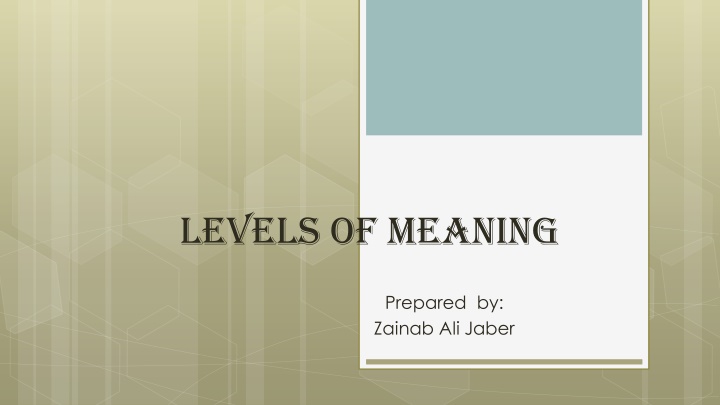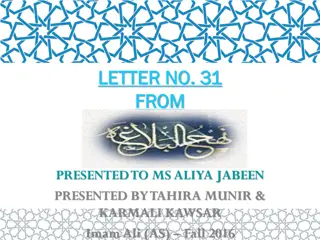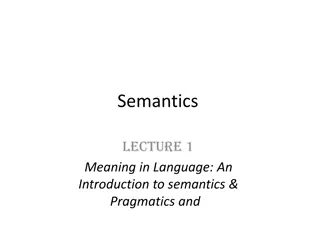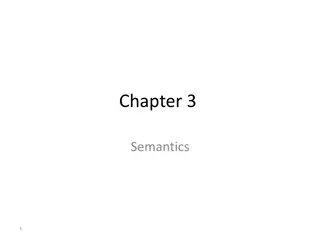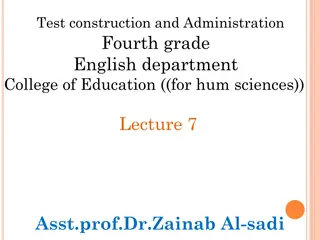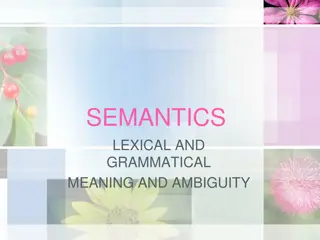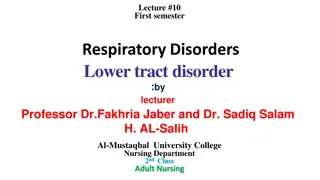Levels of Meaning Explored by Zainab Ali Jaber
Dive into the intricate layers of meaning with Zainab Ali Jaber's insightful analysis. Uncover hidden depths and nuances in the text, as she delves into the intricacies that shape our understanding of literary works. Gain a fresh perspective on the complexities that lie beneath the surface, challenging your perceptions and enriching your appreciation of the subject matter. Through this exploration, you will navigate through various dimensions that offer a deeper insight into the essence of the content.
Download Presentation

Please find below an Image/Link to download the presentation.
The content on the website is provided AS IS for your information and personal use only. It may not be sold, licensed, or shared on other websites without obtaining consent from the author.If you encounter any issues during the download, it is possible that the publisher has removed the file from their server.
You are allowed to download the files provided on this website for personal or commercial use, subject to the condition that they are used lawfully. All files are the property of their respective owners.
The content on the website is provided AS IS for your information and personal use only. It may not be sold, licensed, or shared on other websites without obtaining consent from the author.
E N D
Presentation Transcript
Levels of Meaning Prepared by: Zainab Ali Jaber
content Affective meaning Allusive meaning Associative meaning Attitudinal meaning Collocative meaning Connotation Denotation Interpretive semiotics Paradigmatic axis
1. Denotation versus connotation Approached from a semiotic perspective, signifiers are often classified into two main types: a denotative signifier and a connotative signifier (Al- Shehari 2001: 151). According to Peirce, any sign can produce two kinds of meaning: denotative and connotative. The denotative meaning is the literal (direct) meaning that can be understood via a direct and clear relationship between the sign and the thing it refers to. The connotative meaning, on the other hand, is that meaning which comes into existence as a result of an interaction between the sign and the user s context.
To elaborate, the word (connotation) may be discussed here. The word is derived from the verb which is pronounced in Kuwait and some other places in the Arab world expression ( ag l), i.e., I say (denotation). To reinforce the point, the following signs along with their denotative and connotative meanings in different dialects may be given full consideration (Omani dialect) used in Kuwait to mean stop talking or stop exaggerating to say), ) g l), hence the ) Denotative meaning: Amonster. Connotative meaning: An expert. ) dialect Iraqi ( Denotative meaning: Literally means to escape. Connotative meaning: It means handsome, beautiful, breathtaking, etc
At times, the denotative meaning of a certain lexical item or expression in a given language is wider and less specific than its counterpart in the target language, thus resulting in particularizing translation as opposed to generalizing translation.As an illustration, the following example may be considered: I have to invite all my neighbours to my hen night. A hen night (also known as a hen party or bachelorette party ) is a party held for girls who are about to get married, shortly before their wedding. It can be translated into meaning of / is wider and less specific as it refers to both the hen night and stag night (a stag night, also known as a stag party or bachelor party , which is a party held for men who are about to get married, shortly before their wedding). Translating it into specifying without / / it, there would be generalizing translation, as in: Here, the denotative . / .
2. Connotation: Different overtones It is worth noting that the connotative meaning is not agreed upon by all people, rather it varies from one person to another, from one geographical area to another, from one society or culture to another, and so on. Connotation refers to the personal aspects of meaning, the emotional associations that the word arouses (Kreidler1998: 45).Dickinseta .(2002( hold that there are six types of connotative meaning. They are attitudinal meaning , associative meaning , affective meaning , allusive meaning , collocative meaning , and reflected meaning .
2.1 Attitudinal meaning It refers to the attitude that the language user has according to his/her socio- cultural experiences. For example, all these Arabic verbs in the following expressions: ( - - - refer to the same activity, that is, drinking alcohol. However, they are different in connotation. While the first one / and written language and the second one is also neutral but used in written language only, the third one reflecting the language user s attitude towards both the act of drinking alcohol and the doer of the action. is neutral and used in both spoken has a pejorative overtone, /
2.2 Associative meaning Associative meaning is that part of meaning that has to do with the stereotypical images that have been conjured up in the mind of the language user towards the lexical items used. When Arab interpreters/translators hear/ read the English word secretary, they automatically associate it with the idea of female gender, thus rendering it into ) i.e., female secretary).
2.3 Affective meaning Affective meaning refers to that part of meaning that reflects the choice of lexical items resorted to by the language user and their effect on the addressee. Imagine that you visited your boss at his office, and after two minutes he got angry with you, thus telling, asking, or ordering you: . Lit. I don t want to see your face in the office. Lit. Go out of the office. Lit. If you don t mind, is it possible to leave the office? Although all of them share the same core denotative meaning of go out of the office, the boss attitude to you may produce a different affective impact in each case: very rude in the first, rude in the second and polite in the third.
2.4 Allusive meaning Allusive meaning is that part of meaning that is attached to a referring expression in addition to its denotative meaning by virtue of intertextuality, that is, an expression evokes an associated saying or quotation in such a way that the meaning of that saying or quotation becomes part of overall meaning of the expression (Dickins et al. 2002: 70).As an illustration: the following example quoted from Mahfouz s novel (1971/1977: 23) and the End) may be considered here: The Beginning ) . Here, the writer opts for building an intertextual relation with a Quranic verse, namely verse 12 from ) S r tAl-Hujr t): . The sentence meaning, contains an allusive meaning. along with its lexical items in addition to its basic, straightforward ,
2.5 Collocative meaning Collocative meaning is that part of meaning that is attached to a referring expression in addition to its denotative meaning by virtue of the meaning of other words that collocate well with it, thus forming commonly used expressions. Arabic readers, for instance, tend to say: However, English native speakers tend to use them the other way round: day and night come and go giving and taking black and white sooner or later
To make this point clear, the following example extracted from Muhsin Al-Ramls story (2009: 37) ) Search for a Live Heart) can be given serious consideration: . . ... ... Anumber of collocated expressions can be identified in the original text, such, , , , , as and combinations for native speakers of Arabic. As such, it is essential that translators while translating collocation pay extra attention to the degree of predictability of lexical co-occurrence, that is, the degree of its markedness, as opposed to unmarkedness. All these are examples of unmarked collocations, that is, they are natural .
Further, as stated above in Arabic when expressions involving day and night are used, the word (night) preferably comes before (day) while in English it should be the othe rway round (cf.Almanna 2016: 218 219). Givingfull consideration to these issues, a professional translator may well suggest a translation like this: My mother who remained pinned to the window day and night, puffing on cigarettes, her tearful eyes checking the road to see if he s getting out of a passing car As can be seen, the lexical item (cars) lends itself to a car, thus resulting in an intra-system shift to use Catford s (1965) terminology. Intrasystem shifts occur when the translators, for any reason, ignore the formal equivalent, that is, a term, expression or structure that formally corresponds to that of the original text, and, alternatively, opt for a noncorresponding term, expression or structure in the target language (p. 80).
